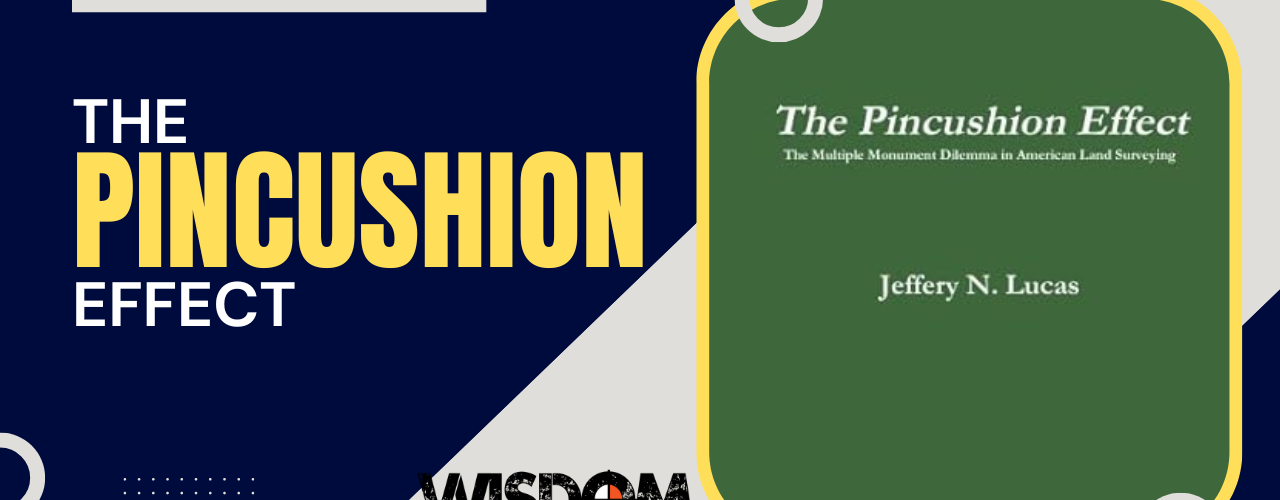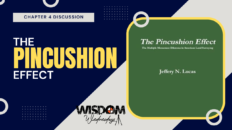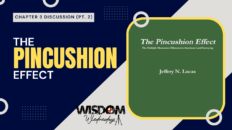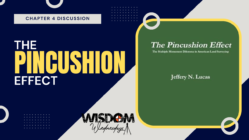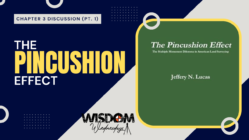Wisdom Wednesdays for the land surveying profession is a bi-weekly roundtable discussion to go over a chapter at a time from our “Surveying Bibles.” The goal is for everyone to read a chapter of a book and then have a roundtable discussion about that chapter. The current book being discussed is The Pincushion Effect by Jeffrey Lucas.
About the book
American land surveying has a dilemma; it’s called the “pincushion corner.” This is a name used to describe the phenomena of multiple boundary monuments being set by land surveyors when only one boundary corner exists under the law. The pincushion has not gone unnoticed by the legal profession and the general public. It is now common knowledge that no two surveyors can agree on the location of any given property corner. The pincushion is physical proof of that notion. Not only is the pincushion becoming a public relations disaster for the profession, it is causing those who might otherwise consider commissioning a survey to decide otherwise. And herein lies the dilemma; no one wants to hire the surveyor because of the way surveying is practiced, the pincushion being emblematic of that practice. This book explores the effect of the pincushion, how the phenomena started, why it exists, and remedies to end the practices that allow the pincushion corner to not only exist, but to flourish.
Meeting summary with AI Companion now supports additional languages in preview. Learn More
Meeting summary for Wisdom Wednesdays for the Land Surveying Profession – “Book Club” (09/25/2024)
Quick recap
The team discussed their recent hiking trip and the importance of professionalism in land surveying, emphasizing the role of surveyors in determining property boundaries and the need for trust between surveyors and clients. They also discussed the concept of the ‘1st surveyor’, the importance of understanding the law, particularly in relation to land surveying, and the standard of care in different states. The conversation ended with a general consensus on the importance of understanding state law in their practice and the need for more accountability and better standards within the profession.
Next steps
- All participants to review and familiarize themselves with common law cases related to boundary surveying in their respective states.
- All participants to research and understand the standard of care and standard of practice for land surveying in their respective states.
- All participants to consider implementing more thorough research and investigation practices in their boundary surveys to avoid potential lawsuits and pincushion effects.
- All participants to explore online resources such as L Eagle (leagle.com) for accessing relevant case law.
- All participants to reflect on how they can hold themselves and their colleagues more accountable for maintaining high professional standards in surveying.
- All participants to consider joining and actively participating in professional surveying organizations to stay updated on best practices and industry discussions.
- Trent Keenan to follow up with California State Board regarding the lack of a codified standard of care for land surveyors in the state.
Summary
Discussing Jeffery’s Book on Land Surveying Principles
The meeting involved a discussion about a book written by Jeffery, which was initially met with skepticism due to its content. Jeffery explained that he had been teaching incorrect principles about land surveying for years, and his book aimed to correct these misconceptions. He also discussed his experiences with negative feedback from other surveyors who disagreed with his views. The team then decided to delve into the book’s content, specifically focusing on the chapter about the duties and responsibilities of a land surveyor. Jeffery emphasized that the courts have never stated that a land surveyor’s duty is merely to state the deed, contrary to what is often taught in evidence and procedures. The team agreed to continue their discussion on this topic.
Defining Professionalism and Standard of Care
Trent Williams initiated a discussion on defining professionalism and how it distinguishes professionals from non-professionals. Kathy and Jeffery suggested that professionals sell opinions, drawing comparisons to clergy, legal, and medical professions. Jeffery highlighted the concept of standard of care, stating professionals must prove negligence to be found liable. The team agreed to further examine professionalism in their field. Trent revealed there is no standard of care in California. Martina shared an experience where her professional opinion was based on evidence, laws, and expertise during a contentious boundary survey.
Surveyors’ Role in Property Boundaries and Trust
Jeffery and Trent emphasized the unique role of surveyors in determining property boundaries and the importance of trust between surveyors and clients. Trent discussed surveyors’ role as mediators in boundary disputes. Jeffery raised the issue of ‘Pincushion Corner’ where multiple monuments lead to confusion. James noted the real estate industry prefers surveyors who don’t scrutinize details closely. Trent stressed the need to maintain professional opinion while adapting when presented with new evidence. Jeffery argued Brown’s approach turned surveying into a math problem, removing the need for professional judgment.
Land Surveying Accuracy, Precision, and Ethics
Jeffery discussed the importance of accuracy and precision in land surveying, emphasizing that it’s not just about mathematical calculations but also about making informed opinions. He highlighted the difference between precise measurements and accurate results, as defined by the title companies. He also pointed out that a surveyor only needs a 51% majority to win a case in court, not a perfect score. The team also discussed the concept of the “pincushion effect” and the importance of professional ethics in surveying. Trent Williams and Trent Keenan shared their thoughts on the matter, with Trent Williams questioning whether GPS coordinates have reduced the occurrence of the pincushion effect.
1st Surveyor Concept and Surveying Challenges
Jeffery discussed the concept of the ‘1st surveyor’ and its relevance in the Federal Manual, emphasizing the role of the surveyor in further subdividing sections and fulfilling the intent of the Federal Government. He credited Walt Roblard for creating the ‘1st surveyor’ concept and mentioned that John Stall had previously brought up similar ideas. Trent Williams was present but did not contribute significantly to the discussion. Trent Williams and Jeffery discussed the challenges of surveying, particularly when dealing with disagreements or unexplained actions by other surveyors. Trent highlighted the importance of understanding the principles behind a survey and being able to defend one’s work. Jeffery added that some surveyors may not want to discuss their methods because they cannot explain them or the reasons behind their decisions. The conversation also touched on the issue of confidential information and the lack of a national practice of including a narrative on surveys. Trent Keenan emphasized the importance of a narrative in sketchy boundary cases.
Understanding Law and Surveying Responsibilities
Trent Williams and Jeffery discussed the importance of understanding the law, particularly in relation to land surveying. They highlighted the five types of laws in the United States and emphasized that boundary law is primarily derived from common law. Jeffery warned against turning a retracement manual into a legal document and stressed the role of surveyors in determining property rights and boundaries. He also shared his experience of being questioned about his ability to determine property rights during a deposition. Trent agreed with Jeffery’s points and shared his own experience of being fined for talking on his cell phone before the law was clearly posted. They concluded that it is the responsibility of every citizen, including surveyors, to know and apply the law.
Understanding Common Law and Case Law in Profession
Trent Keenan and Trent Williams discussed the importance of understanding common law and case law in their profession, emphasizing the availability of online resources and the significance of local administrative law and state regulations. They shared their experiences with the Subdivision Map Act and the LS Act in California, and the role of surveyors in providing professional opinions. Jeffery discussed the stability of common law decisions in boundary law, while James emphasized the importance of surveyors not relying on others for determining property lines. The conversation ended with a general consensus on the importance of understanding state law in their practice.
Standard of Care and Accountability in Surveying
The meeting focused on the standard of care in different states, particularly California and Wisconsin. It was clarified that a common law standard, the reasonably prudent practitioner standard, applies in California and almost every other state. The team also discussed the distinction between the standard of care and the standard of practice, with the latter being a written document. The discussion highlighted the lack of clear standards in the surveying profession, allowing substandard work to be done and called “Boundary Surveys”. The team agreed on the need for more accountability and better standards within the profession.
AI-generated content may be inaccurate or misleading. Always check for accuracy.


